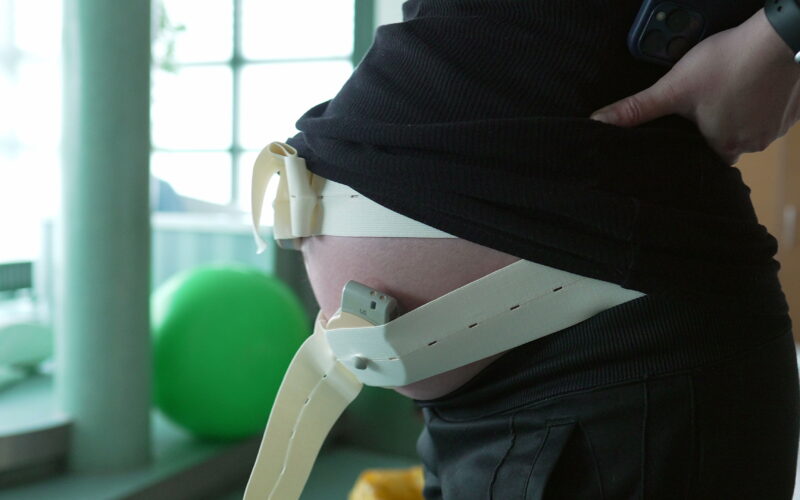A 2024 study found that laboring mothers reported the most satisfaction with their birthing position when they chose it for themselves, as opposed to a healthcare clinician choosing the position for them. Strikingly, the position itself (whether side-lying, squatting, or the nearly-universal OB/GYN preference of having women lie flat on their backs) didn’t even matter as much for maternal satisfaction, so long as the woman had chosen the position for herself.
But outdated provider preferences aren’t the only things holding women back from listening to their bodies and moving freely in labor. As a mother of three, I’ve found that one of the most annoying parts of labor is the electronic fetal monitoring equipment, which can literally keep women from getting into their desired positions while laboring and delivering. Even though I have unmedicated and low-risk births, both of which should put me in the ‘intermittent auscultation’ category instead of ‘continuous fetal monitoring’ category, I have still found myself tethered to straps, wires, and monitors throughout labor. Thankfully, during my last two births, I was offered a new wireless technology.
“Electronic fetal monitoring” refers to using electronic transducers placed on the laboring woman’s abdomen to detect fetal heart rate and uterine contractions [1]. These are held in place by the ubiquitous pink and blue stretchy belly bands. The data is then displayed on a screen for providers to monitor. Women undergo electronic fetal monitoring (EFM) during labor so providers can assess the health of mother and baby and identify when intervention might be necessary. Traditionally, this technology has significantly limited the mobility of laboring women, though some hospitals have smallish mobile devices that the wires plug directly into versus being hooked to a machine in the room. Fortunately, wireless fetal monitoring is on the rise, allowing healthcare clinicians to monitor moms without restricting their movement.
Who needs continuous EFM during labor?
Since the 1970s, continuous EFM has been standard practice in hospitals and some birthing centers. However, the American College of Obstetricians and Gynecologists (ACOG) now recommends its use only for high-risk women. For low-risk women who have an unmedicated and unaugmented (or induced) labor, intermittent fetal monitoring is the best approach [2].
Intermittent fetal monitoring involves a hand-held Doppler, in the case of the hands-on listening approach, or holding the hospital’s standard EFM equipment over the mother’s belly for a few minutes every half hour or hour. The experience of intermittent auscultation can be preferable for more than just increased freedom of movement; for many women, the experience of labor with continuous EFM can be one of being largely left alone in their hospital room and ignored, unless one’s monitor beeps, which then summons a nurse or other provider into the room. Intermittent auscultation, by contrast, requires that staff have a hands-on, eyes-on approach to the woman herself, not simply an automatic response to a machine alarm.
If you are classified as low-risk but are given Pitocin, an epidural, or IV pain meds during labor, your provider may recommend continuous EFM [3]. This is due to the effect these medications can have on a mother and her baby.
The problem with continuous EFM for those who don’t need it
Despite ACOG’s recommendations, many healthcare clinicians assign continuous EFM to all their laboring patients. This is a problematic practice as it has drastically increased the rate of unnecessary cesarean deliveries [4].
Medical intervention is a good that should certainly be available to women in the case of an emergent situation. But, arguably, continuous EFM for women who do not require it contributes to the idea that birth is an inherently medical process, not something their bodies were designed to do. The medicalization of birth has roots in the idea that childbirth is always and everywhere inherently dangerous, or as the Feinberg School of Medicine so unfortunately put it in 2021, the idea that “childbirth is a dangerous and traumatic event, even in the best of circumstances.”
What types of wireless EFMs are available?
For healthcare professionals committed to following best practices, several alternatives to the wires+monitors+straps EFM setup exist, though they are not all created equal. (Again, keep in mind that for low-risk women, the evidence-based option is still intermittent EFM, no matter the technology available.)
I was lucky enough to have wireless, waterproof fetal monitors during my last two labors. The ability to walk around, and even shower if I wanted to, without being hooked to wires was transformational. However, the monitors were bulky and still held in place by the familiar pink and blue belly band straps, often needing to be adjusted when they fell out of place. Another downside was I could not walk far from my room without the monitors losing connection. Many hospitals are switching to wireless monitors that closely resemble the technology we are already familiar with, like the one I was offered during labor. OBIX is one company that provides this type of fetal monitoring.
Another rising wireless EFM technology, and, in my opinion, the preferable option, is the patch system. Phillips and GE Healthcare have patch wireless fetal monitoring systems on the market. Patch technologies have one larger transducer, placed on the center of the abdomen with sticker-like monitors around it. These systems boast more freedom of movement for the mother than other wireless EFMs as they are less likely to fall out of place and lose their monitoring abilities.
Researchers are making EFM more available and comfortable
Northwestern University and The University of North Carolina at Chapel Hill teamed up to create more accurate, cost-effective, and comfortable fetal monitors for laboring women. Their new technology consists of three thin, flexible, sticker-like wireless monitors. Not only do the monitors track fetal heart rate and contraction intensity, they also assess the mother’s body temperature and oxygen levels. The new technology can read the mother’s labor positions and movements, information that has not previously been available. All of the data is easily transported through Bluetooth technology to help avoid connectivity issues.
A 2021 study evaluating the technology examined the data of 500 women in labor who wore both the new wireless technology and traditional EFM monitors. This new technology outperformed traditional monitors in data availability and accuracy. Additionally, the laboring mothers found that they forgot they were being monitored because of how comfortable the sticker-like system was compared to the wired monitors. Lead researcher John A. Rogers commented, “We can use these devices in nearly any setting—from an advanced, high-resource hospital to a remote health clinic or home—all with clinical-grade quality and precise data collection.”
Do laboring women prefer wireless EFM?
According to a 2105 study published in PLoS One, women who were given wireless EFM similar to the type I experienced in the hospital appreciated the fit of the technology and increased mobility [1]. The clinicians who were interviewed also expressed satisfaction with the wireless EFM. One stated that he felt the monitoring experience was “interactive for the patient,” allowing her to feel more “involved in her care.”
One promising potential use of truly wireless EFM is for at-home monitoring of high-risk pregnancies and for at-home labor inductions. A small 2011 study of at-home labor inductions transmitted EFM tracings via Bluetooth to avoid data connectivity issues, and it found women were very satisfied with this approach [5].
Why isn’t everyone using wireless EFM?
With the benefits in mind, the question is “Why isn’t everyone using this technology”? Thankfully, more hospitals are moving to at least offer a wire-free option alongside the Old Faithful equipment. A major barrier to wireless EFM for all is concern about technical delays. The primary problem with wireless EFM in the 2015 study was connectivity issues, either from a delay in data transmission from the transducers to the monitor or from Wifi connection issues [1].
The second major concern has to do with hospital staff training and availability. Switching to or adding wireless EFM is costly. More than just replacing equipment, wireless EFMs require new training for hospital staff, which costs money and takes time.
Another concern noted in the 2015 study was patient education on the device’s safety. Some mothers were worried about the effect the wireless technology could have on the baby or themselves. Finally, this technology is still relatively new, so even though it increases mobility, the range of connectivity remains comparably small, meaning mothers are still limited on how far they can move around outside of their room.
The bottom line on wireless fetal monitoring
Fetal monitoring during labor is an important advancement in technology that can help identify emergent situations. Future research should assess the safety of these monitors and how they compare to traditional monitors. It is also important for providers to understand how to use the additional data provided by the monitors in a way that avoids unnecessary interventions, a problem already associated with EFM. Once established for safety, this new technology could transform mother-baby care in labor and delivery settings for both high and low-income areas.
For low-risk laboring women, intermittent fetal monitoring is recommended. However, high-risk women and those on Pitocin or who have an epidural or IV medications are advised to receive continuous fetal monitoring. Traditional technology prevented laboring women from having the freedom of movement they needed, but new wireless technology is helping solve this issue. Hopefully soon all laboring mothers will be able to enjoy a peaceful laboring space where they can move uninterrupted in the ways that feel best to them.







